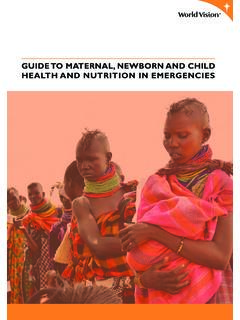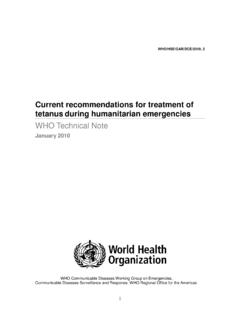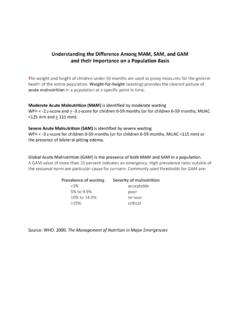Transcription of Nutritional Status Indicators - OER Africa
1 Nutritional Status Assessment and Analysis Nutritional Status Indicators Learner Notes This course is funded by the European Union and implemented by the Food and Agriculture Organization. FAO, 2007 Nutritional Status Assessment and Analysis Lesson: Nutritional Status Indicators Learner Notes 1 Table of contents Learning 2 2 nutrition and health 2 Indicators to interpret Nutritional Status .. 9 Qualities of a good nutrition 12 Selecting 13 Interpreting Indicators .. 14 20 If you want to know 20 Annex I: Skills and knowledge required .. 22 Nutritional Status Assessment and Analysis Lesson: Nutritional Status Indicators Learner Notes 2 Learning objectives At the end of this lesson you will be able to: identify the most commonly used Indicators of Nutritional Status and of causes of malnutrition; and apply criteria for selecting nutrition Indicators in specific contexts.
2 Introduction In order to provide decision-makers with appropriate recommendations on nutrition -related interventions, data and information should cover not only the Nutritional Status of the target population, but also the underlying causes of malnutrition. This lesson will introduce the most commonly used Indicators for measuring Nutritional Status , as well as the Indicators used to understand the immediate, underlying and basic causes of a Nutritional problem. nutrition and health Indicators Let s consider the Triple-A Cycle model: The ASSESSMENT stage aims to define the Nutritional problem in terms of magnitude and distribution. For example: percentage of population affected by underweight or low birth weight.
3 The ANALYSIS stage aims to analyse the causes of malnutrition as represented in the FIVIMS conceptual framework (please, see lesson Assessing Nutritional Status ). For example: women s education level, quality and coverage of health services. Nutritional Status Assessment and Analysis Lesson: Nutritional Status Indicators Learner Notes 3 Different Indicators are used for assessment and analysis purposes. Indicators used to define the Nutritional problem They address the following questions: Who suffers from malnutrition? What is the type of malnutrition? When? Where? Indicators used to analyze the causes of the problem They address the following question: Why are people malnourished or at risk of malnutrition?
4 Let s have a look at the most commonly used Indicators . There are three primary anthropometric indices for children under five years of age. These are based on height and weight body measurement and are standardized by sex and age. Indicator What it measures/What it is used for Low weight-for-height WASTING (acute malnutrition). Wasted children are too light for their height (very thin). Wasting is the result of recent rapid weight loss or a failure to gain weight. Wasting can be reversed when conditions height-for-age or Low length-for-age STUNTING (chronic malnutrition). Stunted children are too short for their age. Stunting develops over a long period as a result of inadequate dietary intake and/or repeated infections.
5 Low weight-for- age UNDERWEIGHT (acute or chronic malnutrition, or both). Underweight children are too light for their age. Children may become underweight either because of wasting or stunting or both. ANTHROPOMETRIC andMICRONUTRIENT DEFICIENCY Indicators FOOD, HEALTH and CARE PRACTICE Indicators Nutritional Status Assessment and Analysis Lesson: Nutritional Status Indicators Learner Notes 4 The following are additional anthropometric Indicators . Particularly, body mass index and low birth weight are used to assess the Nutritional Status of adults. Index/indicator What it measures/What it is used for Body Mass Index (BMI) Calculated as weight divided by height squared, it is commonly used to measure thinness in adolescents, adults and the elderly.
6 Low Birth Weight (LBW) It measures newborn weight and is associated with poor nutrition in mothers (although other factors can also contribute to low birth weight). Mid-Upper Arm Circumference (MUAC) It is an index of body mass. It is usually measured using a MUAC tape that is placed around the middle of the upper arm. It is particularly good for identifying children with a high risk of mortality. Body Mass Index For adolescents, the WHO recommends using BMI for age as BMI varies greatly, particularly at puberty. However, the value of this index is limited by the fact that the precise age of adolescents is often difficult to establish and the classification proposed by WHO can seriously over-estimate malnutrition in this age group.
7 BMI-for-age Z scores and percentiles for children under 5 years are also included in the new WHO Growth Standards (April 2006). Some agencies like Action Contre la Faim (ACF) have developed special weight-for-height tables for use up until the age of 18 years. A major difficulty with BMI is that it varies from one population to another. Much depends upon the proportion between length of trunk and lower limbs. In populations with long legs, for example, the BMI is lower than those with short legs. As a result, the same BMI in different populations can have a completely different physiological significance so that the use of a single BMI threshold for different populations is open to question. There are also specific difficulties in using BMI to measure Nutritional Status of the elderly.
8 The elderly are often stooped due to curvature of the spine. It is therefore difficult to ascertain their exact height. Although there are ways around this, using formulae that calculate height based on arm-span measurements, the formulae may need to be population-specific and are largely unproven in terms of determining risk. Mid-Upper Arm Circumference The Mid-Upper Arm Circumference (MUAC) is particularly good for identifying children with a high risk of mortality. Its diagnostic value lies in the fact that it can be used without reference to age or height, can be carried out quickly and requires little equipment. However, the World Health Organisation In-depth information Nutritional Status Assessment and Analysis Lesson: Nutritional Status Indicators Learner Notes 5recommends using MUAC-for-age.
9 This is because MUAC increase as the child grows, so the smallest children would have a greater chance of being selected on the basis of MUAC criteria only. The International Committee of the Red Cross has developed a stick which measures MUAC-for-height. The increase of MUAC with age is controlled to some extent by assessing MUAC for a given height. However, the estimates of malnutrition given by this indicator are very high, so it should be used with caution. MUAC is not used to assess infants under six months of age. Now, let s look at the contexts in which these anthropometric Indicators are particularly useful1. Indicator What it measures Contexts where it is useful Low weight-for-height (Wasting) Acute malnutrition emergencies .
10 Low weight-for-height (and/or the presence of bilateral oedema) is used to measure prevalence of acute malnutrition (wasting) and is mostly useful to detect existing or recent onset of malnutrition. Wasting is the indicator most commonly assessed through nutrition surveys in emergencies . It is effectively a measure of thinness and there is a direct correlation between level of wasting and risk of mortality. As children become better nourished, their weight-for-height will improve quickly. Weight-for-height measurements are therefore used to assess the effectiveness of emergency interventions at population level and also to monitor the performance of malnourished individuals in specialized feeding programmes, sucha as therapeutic and supplementary feeding.








